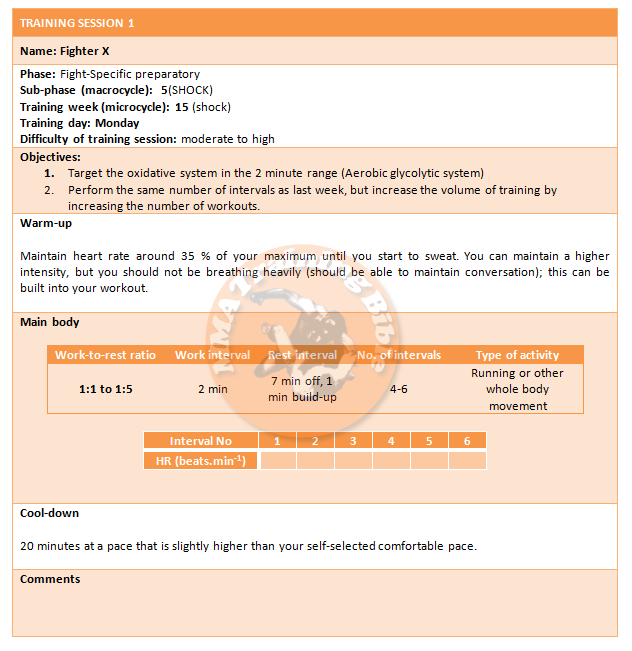Welcome to Part 5 of the MMA Training Bible’s article series on periodization. In Part 1 of the series, you learned that periodization is the process of organizing your training into different phases to the end of managing fatigue, lowering your potential for over-training, and optimizing your performance on fight day (read more in Part 1). In Part 2, you learned all about the big phases of the fight plan; the general preparation phase, the fight-specific preparation phase, the fight camp, the taper (i.e. peaking phase), and the transition. Part 3 moved one level down and showed you how to organize the sub-phases, and Part 4 showed you how to organize the training weeks. In the present and final article in the series, we’re going to show you how to plan a training session.
Every training session that you complete should follow a specific structure and include an introduction, warm-up, main body, and cool-down. Each of these sections will be described in turn below.
The Introduction
The introduction should communicate the objectives of the training session, with an explanation of why these objectives are important, how they fit in to the overall fight plan, and how the training session will achieve the specific objectives. For example, an aerobic endurance session may focus on building capacity in the aerobic energy system (aerobic oxidation). Aerobic energy metabolism supports activity lasting longer than 3 minutes, but it is also aids recovery between high intensity efforts and allows a fighter to maintain a high pace throughout the entire fight. The fighter will target aerobic oxidation using high intensity running-based intervals and work-to-rest ratios of 1:0.5 to 1:1.5 in the 3 to 5 minute range. For more information on the metabolic demands of MMA, check out this article.
The Warm-up
The next part of the session is the warm-up. A warm-up has the effect of physically and mentally preparing the fighter for the main body of the session. As a basic rule, a warm-up should include a general warm-up and a specific warm-up. The general warm-up includes activities like running, skipping, or cycling etc., and is completed at a low intensity for five to 10 minutes (reduce time for beginners, increase time for advanced fighters), or until you sweat. Following this, 10 to 15 minutes of specific activities should be undertaken. This phase of the warm-up should include the specific skills or techniques that will be used in the main body of the training session. As a quick but important side note, there are different types of warm-ups that you should do for different types of workouts.
Main Body
The next part of the training session is the main body. This should focus on just two or three objectives that are linked to the goals of the training week, sub-phase and overall phase of the training plan. As a general rule, fighters should move from non-fatiguing to fatiguing activities during a training session.
Fighters must not be fatigued when learning new skills, as this will reduce the likelihood of mastering it. For example, after completing a general and specific warm-up, the fighter can learn and practice a new skill or tactical element, then perform an agility drill, and move on to strength/power and endurance objectives (although one training session should not include all of these elements – it’s just an example hierarchy!).
Of course, this order can also be manipulated according to the objective. For example, a coach who wishes to test their athlete under pressure could purposefully fatigue them before they engage in a technical element, as this could occur in a fight. Also, placing strength exercise before power drills may improve performance in highly trained athletes. This is because previous excitation of the nervous system may produce an increase in muscle force and rate of force development during subsequent muscle contractions in a phenomenon called post-activation potentiation.
The Cool-down
After the main body of the training session is completed, a cool-down should be undertaken. The optimal method to remove lactate appears to be to undertake a cool-down for 20 minutes at a pace that is slightly higher than your self-selected comfortable pace; however, this may delay glycogen resupply in the muscle (2).
Make sure you stretch after your workout, and not before, because stretching before your workout may reduce your strength and power output during the workout. For more information on stretching, check out the article on ‘maximizing your flexibility with minimal stretching’. And that’s really it for the structure of a training session.
How many training sessions should I complete per day?
I want to shift gears now and talk about a question that I get asked a lot, ‘How many training session per day should I have?’ For beginner/intermediate fighters, one is probably appropriate. But more advanced fighters should aim to split their daily training load into at least two small sessions per day, as this will result in greater improvements compared with performing one long session (1). Those fighters with time available during the day should perform skill-based sessions in the morning when they are fresh, followed by an agility, endurance or resistance workout later in the day, preferably separated by as many hours as possible.
Training Logs
Before I conclude, there is one other thing that I want to mention. It’s about training logs. Regular monitoring of training sessions, and other measures including your resting heart rate, mood status, and sleep patterns, can provide information about your response to training and can help you avoid over-training (read this article series for more information on over-training). A training log is very useful for shedding light on these and other factors. The training log is a very simple, but essential tool that you can use to track your daily responses to training; it provides a large amount of information that can give a coach great insight into the fighter’s response to the training plan. The analysis of training logs, along with data collected from specialized tests and performance results will allow the coach to help the fighter maximise gains. For more information on performance testing in MMA, check out our article series here. To keep things simple, I’ve given you a word doc. version of a simple training log that you can print off and use to monitor your day to day training (click here to download your free copy).
Here is an example of what a typical logged training session may look like for a fighter in the fight specific phase, engaging in a shock sub-phase, in a shock training week, on a Monday workout.

Take home messages
In this article, you learned about the components of an effective training i.e. introduction, warm-up, main body, and cool-down. You also learned about how many sessions you should plan for in a day, and the importance of using a training log.
If you’re interested in this article series or others from The MMA Training Bible, please sign up to our email list at the bottom of the page and you’ll get an email whenever we post a new article. Also, don’t forget to share it with your training partners.
I hope you enjoyed this article and found it useful – and don’t be afraid to ask questions; this stuff can be a little confusing and I’m here to help!
Sincerely,
Dr Jason Gillis
References and further study

Leave a Reply